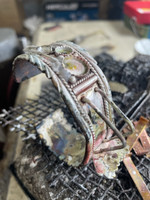The Time-Honored Tradition of Cast Sterling Silver Jewelry
Posted by MRC on Nov 13th 2024
“Sandcast” is a term that is heard in the Native American Jewelry space. What does it mean? Primarily it refers to a method of making silver into shapes that can then be used for jewelry. Navajos, the Zuni, and the Hopi people are all famous for their silversmithing skills. The Spaniards first brought the concept of silversmithing to this continent, introduced it to the Mexicans, who showed the Navajos, who taught the Zuni, who passed it along to the Hopi, so that all three tribes were making silver jewelry by the 1890’s. One of the first ways that the People learned to manipulate silver was tufa casting, or sandcasting. Tufa is a volcanic stone that is found on Navajo Land. The artists would carve out shapes in this soft, but resilient, porous stone, and pour molten silver, usually melted coins, into the mold. Sometimes molds would be made with clay or sand mixtures, but the labor-intensive process is similar.
Casting is a traditional and time-honored way to replicate beautiful designs used in bracelets, rings, earrings, and pendants. We use a casting process to make much of our jewelry as well. We use the “lost wax” or “investment cast” method. In short, it goes something like this:
A silicone mold is made around a piece of designed metal, perhaps a concho for a belt, or a fabricated pendant or bolo tie design by one of our artists. This could be handmade out of sterling silver, nickel or copper. The item is then removed, leaving a negative impression of the design. The space is filled with liquid wax, which, when hardened, creates an exact replica of the original art. This wax replica is attached to a “tree” of sprues, which holds several different wax replicas, and put into an oven, where molten Sterling Silver “magically” takes the place of the wax, which burns away, so now we have the exact replica of the original art, but in sterling silver, instead of wax. The piece still needs a lot of hands-on tender love and care before it can be wearable: for instance, the extra silver in the sprues needs to be removed, and each piece sanded and the edges smoothed. We have an expert team of Indigenous craftsmen who handle this. Then the piece is sent along to our Silversmiths, who shape it, or add design elements, bezel cups for setting stones, stamping, and whatever else is needed to ensure that you have a beautiful piece of handmade jewelry.
We are proud to continue the long-standing tradition of casting to make beautiful hand-made sterling silver jewelry!























